
Thursday, April 26, 2007
Many Facts about the Divine Porportion (Golden Ratio) - (approx. 75% of the Polyhedrons I have made, express the Golden Ratio symmetrically)
Golden Ratio
function pop (url) {var win=window.open(url,'popup','width=525,height=690,resizable=no,scrollbars=yes,location=no,status=no,toolbar=no');win.window.focus();}
The golden ratio, also known as the divine proportion, golden mean, or golden section, is a number often encountered when taking the ratios of distances in simple geometric figures such as the pentagon, pentagram, decagon and dodecahedron. It is denoted , or sometimes .
The designations "phi" (for the golden ratio conjugate ) and "Phi" (for the larger quantity ) are sometimes also used (Knott), although this usage is not necessarily recommended.
The term "golden section" (in German, goldener Schnitt or der goldene Schnitt) seems to first have been used by Martin Ohm in the 1835 2nd edition of his textbook Die Reine Elementar-Mathematik (Livio 2002, p. 6). The first known use of this term in English is in James Sulley's 1875 article on aesthetics in the 9th edition of the Encyclopedia Britannica. The symbol ("phi") was apparently first used by Mark Barr at the beginning of the 20th century in commemoration of the Greek sculptor Phidias (ca. 490-430 BC), who a number of art historians claim made extensive use of the golden ratio in his works (Livio 2002, pp. 5-6). Similarly, the alternate notation is an abbreviation of the Greek tome, meaning "to cut."
In the Season 1 episode "Sabotage" (2005) of the television crime drama NUMB3RS, math genius Charlie Eppes mentions that the golden ratio is found in the pyramids of Giza and the Parthenon at Athens. Similarly, the character Robert Langdon in the novel The Da Vinci Code makes similar such statements (Brown 2003, pp. 93-95). However, claims of the significance of the golden ratio appearing prominently in art, architecture, sculpture, anatomy, etc., tend to be greatly exaggerated.
has surprising connections with continued fractions and the Euclidean algorithm for computing the greatest common divisor of two integers.
Given a rectangle having sides in the ratio , is defined as the unique number such that partitioning the original rectangle into a square and new rectangle as illustrated above results in a new rectangle which also has sides in the ratio (i.e., such that the yellow rectangles shown above are similar). Such a rectangle is called a golden rectangle, and successive points dividing a golden rectangle into squares lie on a logarithmic spiral, giving a figure known as a whirling square.
Based on the above definition, it can immediately be seen that
(1)
giving
(2)
Euclid ca. 300 BC gave an equivalent definition of by defining it in terms of the so-called "extreme and mean ratios" on a line segment, i.e., such that
(3)
for the line segment illustrated above (Livio 2002, pp. 3-4). Plugging in,
(4)
and clearing denominators gives
(5)
which is exactly the same formula obtained above (and incidentally means that is a algebraic number of degree 2.) Using the quadratic equation and taking the positive sign (since the figure is defined so that 1" src="http://mathworld.wolfram.com/images/equations/GoldenRatio/inline15.gif" width=32 border=0>) gives the exact value of , namely
(6)
(7)
(Sloane's A001622).
In an apparent blatant misunderstanding of the difference between an exact quantity and an approximation, the character Robert Langdon in the novel The Da Vinci Code incorrectly defines the golden ratio to be exactly 1.618 (Brown 2003, pp. 93-95).
The legs of a golden triangle (an isosceles triangle with a vertex angle of ) are in a golden ratio to its base and, in fact, this was the method used by Pythagoras to construct . The ratio of the circumradius to the length of the side of a decagon is also ,
(8)
Bisecting a (schematic) Gaullist cross also gives a golden ratio (Gardner 1961, p. 102).
Exact trigonometric formulas for include
(9)
(10)
(11)
The golden ratio is given by the infinite series
(12)
(B. Roselle). Another fascinating connection with the Fibonacci numbers is given by the infinite series
(13)
A representation in terms of a nested radical is
(14)
(Livio 2002, p. 83).
is the "most" irrational number because it has a continued fraction representation
(15)
(Sloane's A000012; Williams 1979, p. 52; Steinhaus 1999, p. 45; Livio 2002, p. 84). This means that the convergents are given by the quadratic recurrence equation
(16)
with , which has solution
(17)
where is the th Fibonacci number. This gives the first few convergents as 1, 2, 3/2, 5/3, 8/5, 13/8, 21/13, 34/21, ... (Sloane's A000045 and A000045), which are good to 0, 0, 0, 1, 1, 2, 2, 2, 3, 3, 4, 4, 5, 5, 5, ... (Sloane's A114540) decimal digits, respectively.
As a result,
infty)x_n==lim_(n->infty)(F_n)/(F_(n-1))," src="http://mathworld.wolfram.com/images/equations/GoldenRatio/equation13.gif" width=148>
(18)
as first proved by Scottish mathematician Robert Simson in 1753 (Wells 1986, p. 62; Livio 2002, p. 101).
The golden ratio also satisfies the recurrence relation
(19)
Taking gives the special case
(20)
Treating (19) as a linear recurrence equation
(21)
in , setting and , and solving gives
(22)
as expected. The powers of the golden ratio also satisfy
(23)
where is a Fibonacci number (Wells 1986, p. 39).
The sine of certain complex numbers involving gives particularly simple answers, for example
(24)
(25)
(D. Hoey, pers. comm.). A curious (although not particularly useful) approximation due to D. Barron is given by
(26)
where is Catalan's constant and is the Euler-Mascheroni constant, which is good to two digits.
In the figure above, three triangles can be inscribed in the rectangle of arbitrary aspect ratio such that the three right triangles have equal areas by dividing and in the golden ratio. Then
(27)
(28)
(29)
which are all equal.
The substitution map
" src="http://mathworld.wolfram.com/images/equations/GoldenRatio/inline69.gif" width=17>
(30)
" src="http://mathworld.wolfram.com/images/equations/GoldenRatio/inline72.gif" width=17>
(31)
gives
01->010->01001->...," src="http://mathworld.wolfram.com/images/equations/GoldenRatio/equation20.gif" width=175>
(32)
giving rise to the sequence
(33)
(Sloane's A003849). Here, the zeros occur at positions 1, 3, 4, 6, 8, 9, 11, 12, ... (Sloane's A000201), and the ones occur at positions 2, 5, 7, 10, 13, 15, 18, ... (Sloane's A001950). These are complementary Beatty sequences generated by and . This sequence also has many connections with the Fibonacci numbers. It is plotted above (mod 2) as a recurrence plot.
Let the continued fraction of be denoted and let the denominators of the convergents be denoted , , ..., . As can be seen from the plots above, the regularity in the continued fraction of means that is one of a set of numbers of measure 0 whose continued fraction sequences do not converge to the Khinchin constant or the Khinchin-Lévy constant.
The golden ratio has Engel expansion 1, 2, 5, 6, 13, 16, 16, 38, 48, 58, 104, ... (Sloane's A028259).
Steinhaus (1983, pp. 48-49) considers the distribution of the fractional parts of in the intervals bounded by 0, , , ..., , 1, and notes that they are much more uniformly distributed than would be expected due to chance (i.e., is close to an equidistributed sequence). In particular, the number of empty intervals for , 2, ..., are a mere 0, 0, 0, 0, 0, 0, 1, 0, 2, 0, 1, 1, 0, 2, 2, ... (Sloane's A036414). The values of for which no bins are left blank are then given by 1, 2, 3, 4, 5, 6, 8, 10, 13, 16, 21, 34, 55, 89, 144, ... (Sloane's A036415). Steinhaus (1983) remarks that the highly uniform distribution has its roots in the continued fraction for .
The sequence , of power fractional parts, where is the fractional part, is equidistributed for almost all real numbers 1" src="http://mathworld.wolfram.com/images/equations/GoldenRatio/inline93.gif" width=32 border=0>, with the golden ratio being one exception.
Salem showed that the set of Pisot numbers is closed, with the smallest accumulation point of the set (Le Lionnais 1983).
SEE ALSO: Beraha Constants, Decagon, Equidistributed Sequence, Euclidean Algorithm, Five Disks Problem, Golden Angle, Golden Gnomon, Golden Ratio Approximations, Golden Ratio Conjugate, Golden Rectangle, Golden Triangle, Icosidodecahedron, Noble Number, Pentagon, Pentagram, Phi Number System, Phyllotaxis, Pisot Number, Plastic Constant, Power Fractional Parts, Ramanujan Continued Fractions, Rogers-Ramanujan Continued Fraction, Secant Method. [Pages Linking Here]
RELATED WOLFRAM SITES: http://functions.wolfram.com/Constants/GoldenRatio/
REFERENCES:
Boyer, C. B. History of Mathematics. New York: Wiley, p. 56, 1968.
Brown, D. The Da Vinci Code. New York: Doubleday, 2003.
Coxeter, H. S. M. "The Golden Section, Phyllotaxis, and Wythoff's Game." Scripta Mathematica 19, 135-143, 1953.
Dixon, R. Mathographics. New York: Dover, pp. 30-31 and 50, 1991.
Finch, S. R. "The Golden Mean." §1.2 in Mathematical Constants. Cambridge, England: Cambridge University Press, pp. 5-12, 2003.
Gardner, M. "Phi: The Golden Ratio." Ch. 8 in The Second Scientific American Book of Mathematical Puzzles & Diversions, A New Selection. New York: Simon and Schuster, pp. 89-103, 1961.
Gardner, M. "Notes on a Fringe-Watcher: The Cult of the Golden Ratio." Skeptical Inquirer 18, 243-247, 1994.
Hambridge, J. The Elements of Dynamic Stability. New York: Dover, 1967.
Herz-Fischler, R. A Mathematical History of the Golden Number. New York: Dover, 1998.
Hofstetter, K. "A Simple Construction of the Golden Ratio." Forum Geom. 2, 65-66, 2002. http://forumgeom.fau.edu/FG2002volume2/FG200208index.html.
Hofstetter, K. "A 4-Step Construction of the Golden Ratio." Forum Geom. 6, 179-180, 2006. http://forumgeom.fau.edu/FG2006volume6/FG200618index.html.
Huntley, H. E. The Divine Proportion. New York: Dover, 1970.
Knott, R. "Fibonacci Numbers and the Golden Section." http://www.mcs.surrey.ac.uk/Personal/R.Knott/Fibonacci/.
Le Lionnais, F. Les nombres remarquables. Paris: Hermann, p. 40, 1983.
Livio, M. The Golden Ratio: The Story of Phi, the World's Most Astonishing Number. New York: Broadway Books, 2002.
Markowsky, G. "Misconceptions About the Golden Ratio." College Math. J. 23, 2-19, 1992.
Ogilvy, C. S. Excursions in Geometry. New York: Dover, pp. 122-134, 1990.
Ohm, M. die Reine Elementar-Mathematik. Berlin: Jonas Veilags-Buchhandlung, 1835.
Olariu, A. "Golden Section and the Art of Painting." 18 Aug 1999. http://arxiv.org/abs/physics/9908036/.
Pappas, T. "Anatomy & the Golden Section." The Joy of Mathematics. San Carlos, CA: Wide World Publ./Tetra, pp. 32-33, 1989.
Saaty, T. L. and Kainen, P. C. The Four-Color Problem: Assaults and Conquest. New York: Dover, p. 148, 1986.
Sloane, N. J. A. Sequences A000012/M0003, A000201/M2322, A001622/M4046, A001950/M1332, A003849, A028259, A036414, A036415, and A114540 in "The On-Line Encyclopedia of Integer Sequences."
Steinhaus, H. Mathematical Snapshots, 3rd ed. New York: Dover, p. 45, 1999.
Trott, M. The Mathematica GuideBook for Programming. New York: Springer-Verlag, p. 175, 2004. http://www.mathematicaguidebooks.org/.
van Zanten, A. J. "The Golden Ratio in the Arts of Painting, Building, and Mathematics." Nieuw Arch. Wisk. 17, 229-245, 1999.
Walser, R. Der Goldene Schnitt. Stuttgart, Germany: Teubner, 1993.
Weisstein, E. W. "Books about Golden Ratio." http://www.ericweisstein.com/encyclopedias/books/GoldenRatio.html.
Wells, D. The Penguin Dictionary of Curious and Interesting Numbers. Middlesex, England: Penguin Books, pp. 36-49, 1986.
Wells, D. The Penguin Dictionary of Curious and Interesting Geometry. London: Penguin, pp. 87-88, 1991.
Williams, R. "The Golden Proportion." §2-7 in The Geometrical Foundation of Natural Structure: A Source Book of Design. New York: Dover, pp. 52-53, 1979.
Zeising, A. Neue Lehre von den Proportionen des menschlichen Körpers, aus einem bisher unerkannt gebliebenen, die ganze Natur und Kunst durchdringenden morphologischen Grundgesetze entwickelt und mit einer vollständigen historischen Uebersicht der bisherigen Systeme begleitet. Leipzig, Germany: Weigel, 1854.
function pop (url) {var win=window.open(url,'popup','width=525,height=690,resizable=no,scrollbars=yes,location=no,status=no,toolbar=no');win.window.focus();}
The golden ratio, also known as the divine proportion, golden mean, or golden section, is a number often encountered when taking the ratios of distances in simple geometric figures such as the pentagon, pentagram, decagon and dodecahedron. It is denoted , or sometimes .
The designations "phi" (for the golden ratio conjugate ) and "Phi" (for the larger quantity ) are sometimes also used (Knott), although this usage is not necessarily recommended.
The term "golden section" (in German, goldener Schnitt or der goldene Schnitt) seems to first have been used by Martin Ohm in the 1835 2nd edition of his textbook Die Reine Elementar-Mathematik (Livio 2002, p. 6). The first known use of this term in English is in James Sulley's 1875 article on aesthetics in the 9th edition of the Encyclopedia Britannica. The symbol ("phi") was apparently first used by Mark Barr at the beginning of the 20th century in commemoration of the Greek sculptor Phidias (ca. 490-430 BC), who a number of art historians claim made extensive use of the golden ratio in his works (Livio 2002, pp. 5-6). Similarly, the alternate notation is an abbreviation of the Greek tome, meaning "to cut."
In the Season 1 episode "Sabotage" (2005) of the television crime drama NUMB3RS, math genius Charlie Eppes mentions that the golden ratio is found in the pyramids of Giza and the Parthenon at Athens. Similarly, the character Robert Langdon in the novel The Da Vinci Code makes similar such statements (Brown 2003, pp. 93-95). However, claims of the significance of the golden ratio appearing prominently in art, architecture, sculpture, anatomy, etc., tend to be greatly exaggerated.
has surprising connections with continued fractions and the Euclidean algorithm for computing the greatest common divisor of two integers.
Given a rectangle having sides in the ratio , is defined as the unique number such that partitioning the original rectangle into a square and new rectangle as illustrated above results in a new rectangle which also has sides in the ratio (i.e., such that the yellow rectangles shown above are similar). Such a rectangle is called a golden rectangle, and successive points dividing a golden rectangle into squares lie on a logarithmic spiral, giving a figure known as a whirling square.
Based on the above definition, it can immediately be seen that
(1)
giving
(2)
Euclid ca. 300 BC gave an equivalent definition of by defining it in terms of the so-called "extreme and mean ratios" on a line segment, i.e., such that
(3)
for the line segment illustrated above (Livio 2002, pp. 3-4). Plugging in,
(4)
and clearing denominators gives
(5)
which is exactly the same formula obtained above (and incidentally means that is a algebraic number of degree 2.) Using the quadratic equation and taking the positive sign (since the figure is defined so that 1" src="http://mathworld.wolfram.com/images/equations/GoldenRatio/inline15.gif" width=32 border=0>) gives the exact value of , namely
(6)
(7)
(Sloane's A001622).
In an apparent blatant misunderstanding of the difference between an exact quantity and an approximation, the character Robert Langdon in the novel The Da Vinci Code incorrectly defines the golden ratio to be exactly 1.618 (Brown 2003, pp. 93-95).
The legs of a golden triangle (an isosceles triangle with a vertex angle of ) are in a golden ratio to its base and, in fact, this was the method used by Pythagoras to construct . The ratio of the circumradius to the length of the side of a decagon is also ,
(8)
Bisecting a (schematic) Gaullist cross also gives a golden ratio (Gardner 1961, p. 102).
Exact trigonometric formulas for include
(9)
(10)
(11)
The golden ratio is given by the infinite series
(12)
(B. Roselle). Another fascinating connection with the Fibonacci numbers is given by the infinite series
(13)
A representation in terms of a nested radical is
(14)
(Livio 2002, p. 83).
is the "most" irrational number because it has a continued fraction representation
(15)
(Sloane's A000012; Williams 1979, p. 52; Steinhaus 1999, p. 45; Livio 2002, p. 84). This means that the convergents are given by the quadratic recurrence equation
(16)
with , which has solution
(17)
where is the th Fibonacci number. This gives the first few convergents as 1, 2, 3/2, 5/3, 8/5, 13/8, 21/13, 34/21, ... (Sloane's A000045 and A000045), which are good to 0, 0, 0, 1, 1, 2, 2, 2, 3, 3, 4, 4, 5, 5, 5, ... (Sloane's A114540) decimal digits, respectively.
As a result,
infty)x_n==lim_(n->infty)(F_n)/(F_(n-1))," src="http://mathworld.wolfram.com/images/equations/GoldenRatio/equation13.gif" width=148>
(18)
as first proved by Scottish mathematician Robert Simson in 1753 (Wells 1986, p. 62; Livio 2002, p. 101).
The golden ratio also satisfies the recurrence relation
(19)
Taking gives the special case
(20)
Treating (19) as a linear recurrence equation
(21)
in , setting and , and solving gives
(22)
as expected. The powers of the golden ratio also satisfy
(23)
where is a Fibonacci number (Wells 1986, p. 39).
The sine of certain complex numbers involving gives particularly simple answers, for example
(24)
(25)
(D. Hoey, pers. comm.). A curious (although not particularly useful) approximation due to D. Barron is given by
(26)
where is Catalan's constant and is the Euler-Mascheroni constant, which is good to two digits.
In the figure above, three triangles can be inscribed in the rectangle of arbitrary aspect ratio such that the three right triangles have equal areas by dividing and in the golden ratio. Then
(27)
(28)
(29)
which are all equal.
The substitution map
" src="http://mathworld.wolfram.com/images/equations/GoldenRatio/inline69.gif" width=17>
(30)
" src="http://mathworld.wolfram.com/images/equations/GoldenRatio/inline72.gif" width=17>
(31)
gives
01->010->01001->...," src="http://mathworld.wolfram.com/images/equations/GoldenRatio/equation20.gif" width=175>
(32)
giving rise to the sequence
(33)
(Sloane's A003849). Here, the zeros occur at positions 1, 3, 4, 6, 8, 9, 11, 12, ... (Sloane's A000201), and the ones occur at positions 2, 5, 7, 10, 13, 15, 18, ... (Sloane's A001950). These are complementary Beatty sequences generated by and . This sequence also has many connections with the Fibonacci numbers. It is plotted above (mod 2) as a recurrence plot.
Let the continued fraction of be denoted and let the denominators of the convergents be denoted , , ..., . As can be seen from the plots above, the regularity in the continued fraction of means that is one of a set of numbers of measure 0 whose continued fraction sequences do not converge to the Khinchin constant or the Khinchin-Lévy constant.
The golden ratio has Engel expansion 1, 2, 5, 6, 13, 16, 16, 38, 48, 58, 104, ... (Sloane's A028259).
Steinhaus (1983, pp. 48-49) considers the distribution of the fractional parts of in the intervals bounded by 0, , , ..., , 1, and notes that they are much more uniformly distributed than would be expected due to chance (i.e., is close to an equidistributed sequence). In particular, the number of empty intervals for , 2, ..., are a mere 0, 0, 0, 0, 0, 0, 1, 0, 2, 0, 1, 1, 0, 2, 2, ... (Sloane's A036414). The values of for which no bins are left blank are then given by 1, 2, 3, 4, 5, 6, 8, 10, 13, 16, 21, 34, 55, 89, 144, ... (Sloane's A036415). Steinhaus (1983) remarks that the highly uniform distribution has its roots in the continued fraction for .
The sequence , of power fractional parts, where is the fractional part, is equidistributed for almost all real numbers 1" src="http://mathworld.wolfram.com/images/equations/GoldenRatio/inline93.gif" width=32 border=0>, with the golden ratio being one exception.
Salem showed that the set of Pisot numbers is closed, with the smallest accumulation point of the set (Le Lionnais 1983).
SEE ALSO: Beraha Constants, Decagon, Equidistributed Sequence, Euclidean Algorithm, Five Disks Problem, Golden Angle, Golden Gnomon, Golden Ratio Approximations, Golden Ratio Conjugate, Golden Rectangle, Golden Triangle, Icosidodecahedron, Noble Number, Pentagon, Pentagram, Phi Number System, Phyllotaxis, Pisot Number, Plastic Constant, Power Fractional Parts, Ramanujan Continued Fractions, Rogers-Ramanujan Continued Fraction, Secant Method. [Pages Linking Here]
RELATED WOLFRAM SITES: http://functions.wolfram.com/Constants/GoldenRatio/
REFERENCES:
Boyer, C. B. History of Mathematics. New York: Wiley, p. 56, 1968.
Brown, D. The Da Vinci Code. New York: Doubleday, 2003.
Coxeter, H. S. M. "The Golden Section, Phyllotaxis, and Wythoff's Game." Scripta Mathematica 19, 135-143, 1953.
Dixon, R. Mathographics. New York: Dover, pp. 30-31 and 50, 1991.
Finch, S. R. "The Golden Mean." §1.2 in Mathematical Constants. Cambridge, England: Cambridge University Press, pp. 5-12, 2003.
Gardner, M. "Phi: The Golden Ratio." Ch. 8 in The Second Scientific American Book of Mathematical Puzzles & Diversions, A New Selection. New York: Simon and Schuster, pp. 89-103, 1961.
Gardner, M. "Notes on a Fringe-Watcher: The Cult of the Golden Ratio." Skeptical Inquirer 18, 243-247, 1994.
Hambridge, J. The Elements of Dynamic Stability. New York: Dover, 1967.
Herz-Fischler, R. A Mathematical History of the Golden Number. New York: Dover, 1998.
Hofstetter, K. "A Simple Construction of the Golden Ratio." Forum Geom. 2, 65-66, 2002. http://forumgeom.fau.edu/FG2002volume2/FG200208index.html.
Hofstetter, K. "A 4-Step Construction of the Golden Ratio." Forum Geom. 6, 179-180, 2006. http://forumgeom.fau.edu/FG2006volume6/FG200618index.html.
Huntley, H. E. The Divine Proportion. New York: Dover, 1970.
Knott, R. "Fibonacci Numbers and the Golden Section." http://www.mcs.surrey.ac.uk/Personal/R.Knott/Fibonacci/.
Le Lionnais, F. Les nombres remarquables. Paris: Hermann, p. 40, 1983.
Livio, M. The Golden Ratio: The Story of Phi, the World's Most Astonishing Number. New York: Broadway Books, 2002.
Markowsky, G. "Misconceptions About the Golden Ratio." College Math. J. 23, 2-19, 1992.
Ogilvy, C. S. Excursions in Geometry. New York: Dover, pp. 122-134, 1990.
Ohm, M. die Reine Elementar-Mathematik. Berlin: Jonas Veilags-Buchhandlung, 1835.
Olariu, A. "Golden Section and the Art of Painting." 18 Aug 1999. http://arxiv.org/abs/physics/9908036/.
Pappas, T. "Anatomy & the Golden Section." The Joy of Mathematics. San Carlos, CA: Wide World Publ./Tetra, pp. 32-33, 1989.
Saaty, T. L. and Kainen, P. C. The Four-Color Problem: Assaults and Conquest. New York: Dover, p. 148, 1986.
Sloane, N. J. A. Sequences A000012/M0003, A000201/M2322, A001622/M4046, A001950/M1332, A003849, A028259, A036414, A036415, and A114540 in "The On-Line Encyclopedia of Integer Sequences."
Steinhaus, H. Mathematical Snapshots, 3rd ed. New York: Dover, p. 45, 1999.
Trott, M. The Mathematica GuideBook for Programming. New York: Springer-Verlag, p. 175, 2004. http://www.mathematicaguidebooks.org/.
van Zanten, A. J. "The Golden Ratio in the Arts of Painting, Building, and Mathematics." Nieuw Arch. Wisk. 17, 229-245, 1999.
Walser, R. Der Goldene Schnitt. Stuttgart, Germany: Teubner, 1993.
Weisstein, E. W. "Books about Golden Ratio." http://www.ericweisstein.com/encyclopedias/books/GoldenRatio.html.
Wells, D. The Penguin Dictionary of Curious and Interesting Numbers. Middlesex, England: Penguin Books, pp. 36-49, 1986.
Wells, D. The Penguin Dictionary of Curious and Interesting Geometry. London: Penguin, pp. 87-88, 1991.
Williams, R. "The Golden Proportion." §2-7 in The Geometrical Foundation of Natural Structure: A Source Book of Design. New York: Dover, pp. 52-53, 1979.
Zeising, A. Neue Lehre von den Proportionen des menschlichen Körpers, aus einem bisher unerkannt gebliebenen, die ganze Natur und Kunst durchdringenden morphologischen Grundgesetze entwickelt und mit einer vollständigen historischen Uebersicht der bisherigen Systeme begleitet. Leipzig, Germany: Weigel, 1854.
Historic Mathematical Facts about The Great Stellated Dodecahedron
Great Stellated Dodecahedron
The great stellated dodecahedron is one of the Kepler-Poinsot solids. It is also uniform polyhedron , Wenninger model , and is the third dodecahedron stellation (Wenninger 1989). Its dual is the great icosahedron. The great stellated dodecahedron has Schläfli symbol and Wythoff symbol . It has 12 pentagrammic faces.
The great stellated dodecahedron was published by Wenzel Jamnitzer in 1568. It was rediscovered by Kepler (and published in his work Harmonice Mundi in 1619), and again by Poinsot in 1809.
Its circumradius for unit edge length is
(1)
(2)
where is the golden ratio.
The skeleton of the great stellated dodecahedron is isomorphic to the dodecahedral graph.
The great stellated dodecahedron can be constructed from a dodecahedron by selecting the 144 sets of five coplanar vertices, then discarding sets whose edges correspond to the edges of the original dodecahedron. This gives 12 pentagrams of edge length , where is the golden ratio.
Another way to construct a great stellated dodecahedron via cumulation is to make 20 triangular pyramids with side length (the golden ratio) times the base, as illustrated above, and attach them to the sides of an icosahedron. The height of these pyramids is then .
Cumulating a dodecahedron to construct a great stellated dodecahedron produces a solid with edge lengths
(3)
(4)
The surface area and volume of such a great stellated dodecahedron are
(5)
(6)
The convex hull of the great stellated dodecahedron is a regular dodecahedron and the dual of the dodecahedron is the icosahedron, so the dual of the great stellated dodecahedron (i.e., the great icosahedron) is one of the icosahedron stellations (Wenninger 1983, p. 40)
SEE ALSO: Dodecahedron, Dodecahedron Stellations, Great Dodecahedron, Great Icosahedron, Great Stellated Truncated Dodecahedron, Kepler-Poinsot Solid, Small Stellated Dodecahedron, Spiky, Stellation. [Pages Linking Here]
The great stellated dodecahedron is one of the Kepler-Poinsot solids. It is also uniform polyhedron , Wenninger model , and is the third dodecahedron stellation (Wenninger 1989). Its dual is the great icosahedron. The great stellated dodecahedron has Schläfli symbol and Wythoff symbol . It has 12 pentagrammic faces.
The great stellated dodecahedron was published by Wenzel Jamnitzer in 1568. It was rediscovered by Kepler (and published in his work Harmonice Mundi in 1619), and again by Poinsot in 1809.
Its circumradius for unit edge length is
(1)
(2)
where is the golden ratio.
The skeleton of the great stellated dodecahedron is isomorphic to the dodecahedral graph.
The great stellated dodecahedron can be constructed from a dodecahedron by selecting the 144 sets of five coplanar vertices, then discarding sets whose edges correspond to the edges of the original dodecahedron. This gives 12 pentagrams of edge length , where is the golden ratio.
Another way to construct a great stellated dodecahedron via cumulation is to make 20 triangular pyramids with side length (the golden ratio) times the base, as illustrated above, and attach them to the sides of an icosahedron. The height of these pyramids is then .
Cumulating a dodecahedron to construct a great stellated dodecahedron produces a solid with edge lengths
(3)
(4)
The surface area and volume of such a great stellated dodecahedron are
(5)
(6)
The convex hull of the great stellated dodecahedron is a regular dodecahedron and the dual of the dodecahedron is the icosahedron, so the dual of the great stellated dodecahedron (i.e., the great icosahedron) is one of the icosahedron stellations (Wenninger 1983, p. 40)
SEE ALSO: Dodecahedron, Dodecahedron Stellations, Great Dodecahedron, Great Icosahedron, Great Stellated Truncated Dodecahedron, Kepler-Poinsot Solid, Small Stellated Dodecahedron, Spiky, Stellation. [Pages Linking Here]
Sunday, April 22, 2007
Tuesday, April 10, 2007
Thursday, April 5, 2007
Sunday, April 1, 2007
Subscribe to:
Posts (Atom)

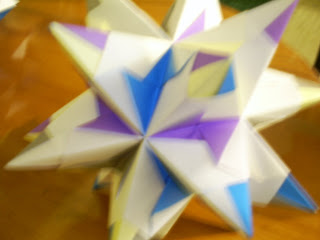


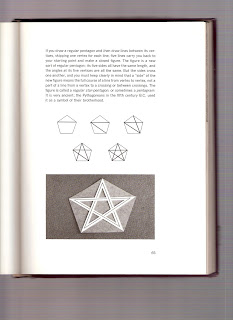
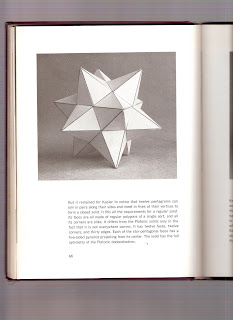



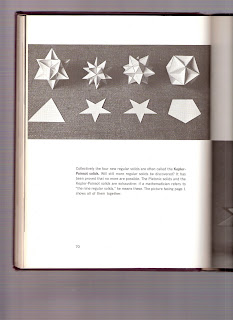

.jpg)
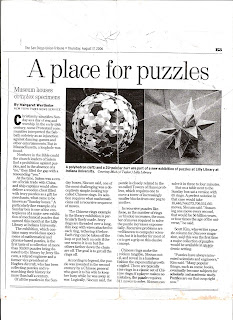

.jpg)

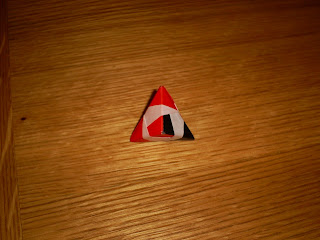

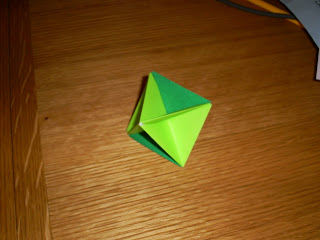
.jpg)





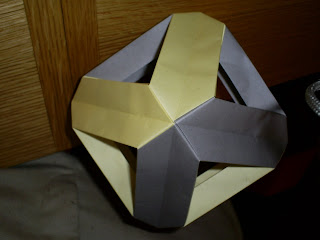



.jpg)
